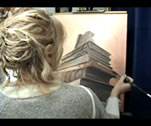This section provides a list of techniques, materials, and common references that are frequently used in the design and decorative painting profession.
In Europe, oak paneling represents the nec plus ultra of wall coverings. In the United States you may find in some homes the traditional British pine paneling, more or less ornate, depending on the status of the house. The nobler version provides a backdrop of timeless warmth and elegance to a room; unfortunately, oak paneling is out of the reach of most people's purses. The alternative is to copy these woods, resorting to faux wood technique. This can reach wonderful results assuming that the selected wood variety is replicated with subtlety. A poor technique or vision is particularly unkind to this bravura finish, and it is better to use instead a strie technique or the sketchy look donned by Christian Berard. To complete a balance paneling, measure will rule your drawing. You need to keep the style and dimensions of the space in mind and the location of the furniture to determine an appropriate design for the panels. In regards to painted panels, as opposed to grained panels, the most remarkable ones were produced during the Roman Empire during the reign of Louis XIII, in sixteenth and seventeenth century Italy, and in Sweden and Russia. Paneling a room with a simple strike of paint sets a mood and a refinement satisfying those in search of structure and neatness. It also distracts the eye from defects and compensates for a nondescript room.
To color a glaze, a wash, a varnish or paint, powdered pigments are used to impart a brighter and more concentrated tint. The finer the work the more refined they ought to be. To mix a gesso or a glaze destined to walls, you need to crush the pigments with a pestle in water or oil, depending on the medium that will carry them. To tint a varnish, you want to buy a highly ground pigment from a reliable brand such as Sennelier. Even after a serious grinding, a fine pigment may leave occasional lumps that will explode on your surface leaving unsightly and hard to remove streaks; for this reason, a mixed medium must always and repeatedly be strained to catch lumps or debris. For the neophyte, mixing with fine oil or gouache, already ground, is safer. Many professionals use Universal tints, sold in paint stores. They offer most of the time a quality result, yet, they do not yield the deepness of a natural pigment nor do they bring fun in the execution of the work.
It is an Italian town buried in 79AD, following a volcanic eruption. It was unearthed then rediscovered by the public in the early 18th century. We distinguish three different style periods. Pompei is the epitome of mural paintings and faux paintings. Their themes are picked among scenes from the daily life, narratives of the Gods' accomplishments, nature, landscapes, etc. The wall surfaces are geometrically divided into panels, sometimes including three dimensional effects and perspectives, with symbols set into cartridges, or imitations of precious materials and so forth. Similar frescoes were found in other surrounding towns, such as Stabiae, Oplontis, Boscoreale, and in Rome, just to mention the Doma Aurea. The Pompeian reference generally designates this Roman art period that remained unrivaled for its visionary designs allied to their quality of execution: freshness, poetry, sense of perspective, freedom of expression, and colors. These frescoes and their surroundings are breathtaking. They have inspired many a painter: Raphael recreated an aspect of this grand art in the Vatican lodges, with a display of Grotesque art. The latter derives from the Roman mythology intertwined with exuberant nature, animals, monsters and symbolism. It bears the Etruscan and Greek influences. The best painters were hired by rich families to decorate their homes, yet if possible, Stabiae frescoed paintings surpass them all in beauty. Italian artists as well as diplomats and Heads of Statesbrought back from Italy and spread the vision of these exceptional paintings. Artists were commissioned to replicate them. The Adam style, or the Swedish style that we know, stemmed from this marvelous art. There was not one court in Europe that was not subjugated by this discovered art. Nowadays, Pompeian style is more synonymous with pale or decayed paintings, but this is a short cut through this art and a biased view. Today, washed out colors are in fashion, therefore this is the vision that we like to retain of these frescoes, obscuring the fact that they once were bright, and that few people can appreciate their quality, much less afford their imitation.
A sturdy base coat must be underlain before attempting to paint a wall, a piece of furniture or almost anything else. The idea behind it is to protect and isolate the material to be painted, whereby allowing the topcoat to last longer. Primer is granted a hiding power that helps conceal stains, such as pine knots for instance. Unfortunately, it is almost impossible to hide fresh pine knots that will keep sipping through the paint and discoloring it. Similarly, furniture that was previously stained, particularly with a mahogany shade, and sanded will keep exuding the tenacious red stain that was once abundantly poured into its grain. In this case, a more drastic remedy would be to seal the wood with a finish before priming it. Some primers, like the Uma brand, adhere to almost any surface.
She is the French queen of modern design, saluted for her sartorial and pure lines of design, sober hues, measured and well balanced architectural input. Her signature is reminiscent of Japanese interiors, with a more futuristic vision.






